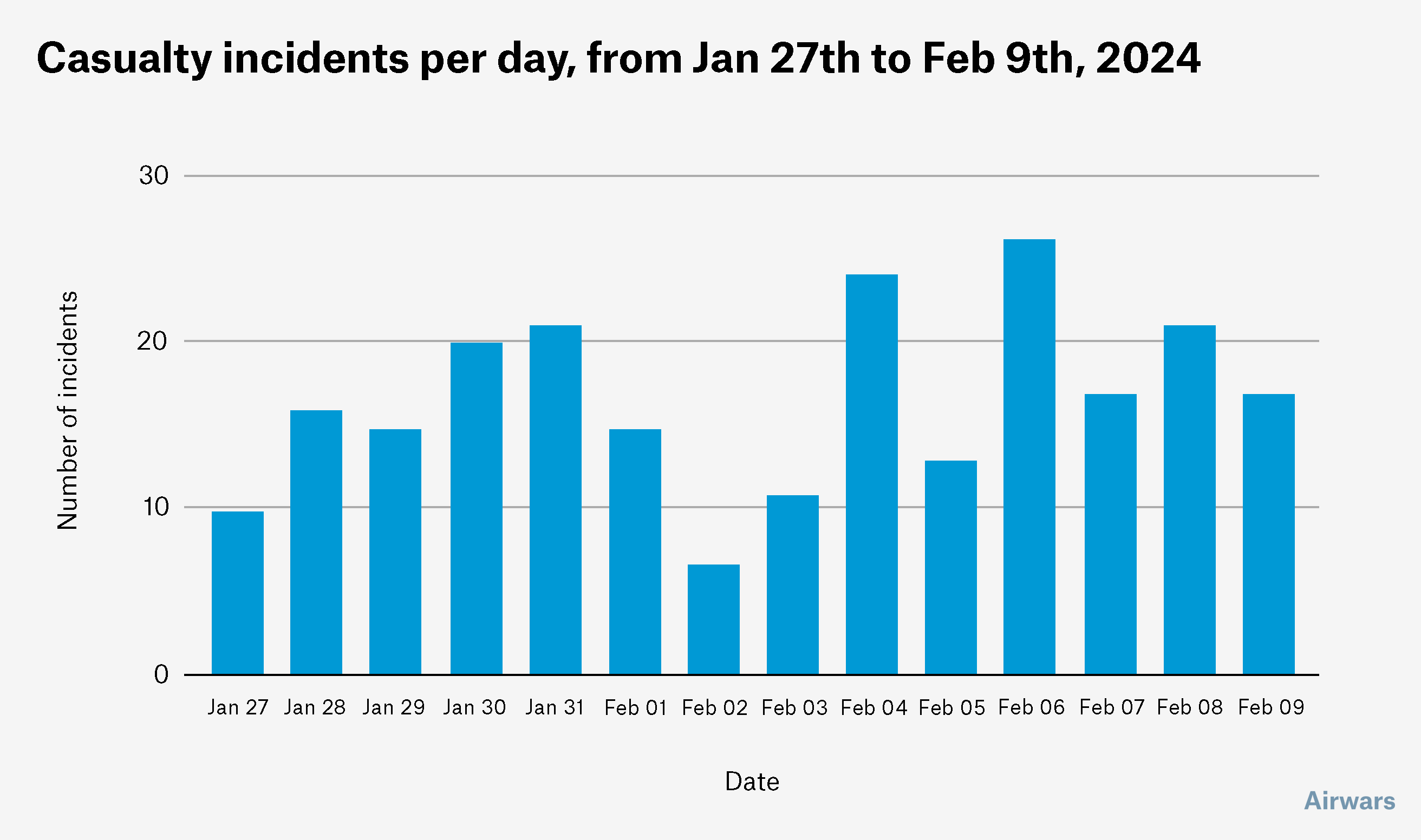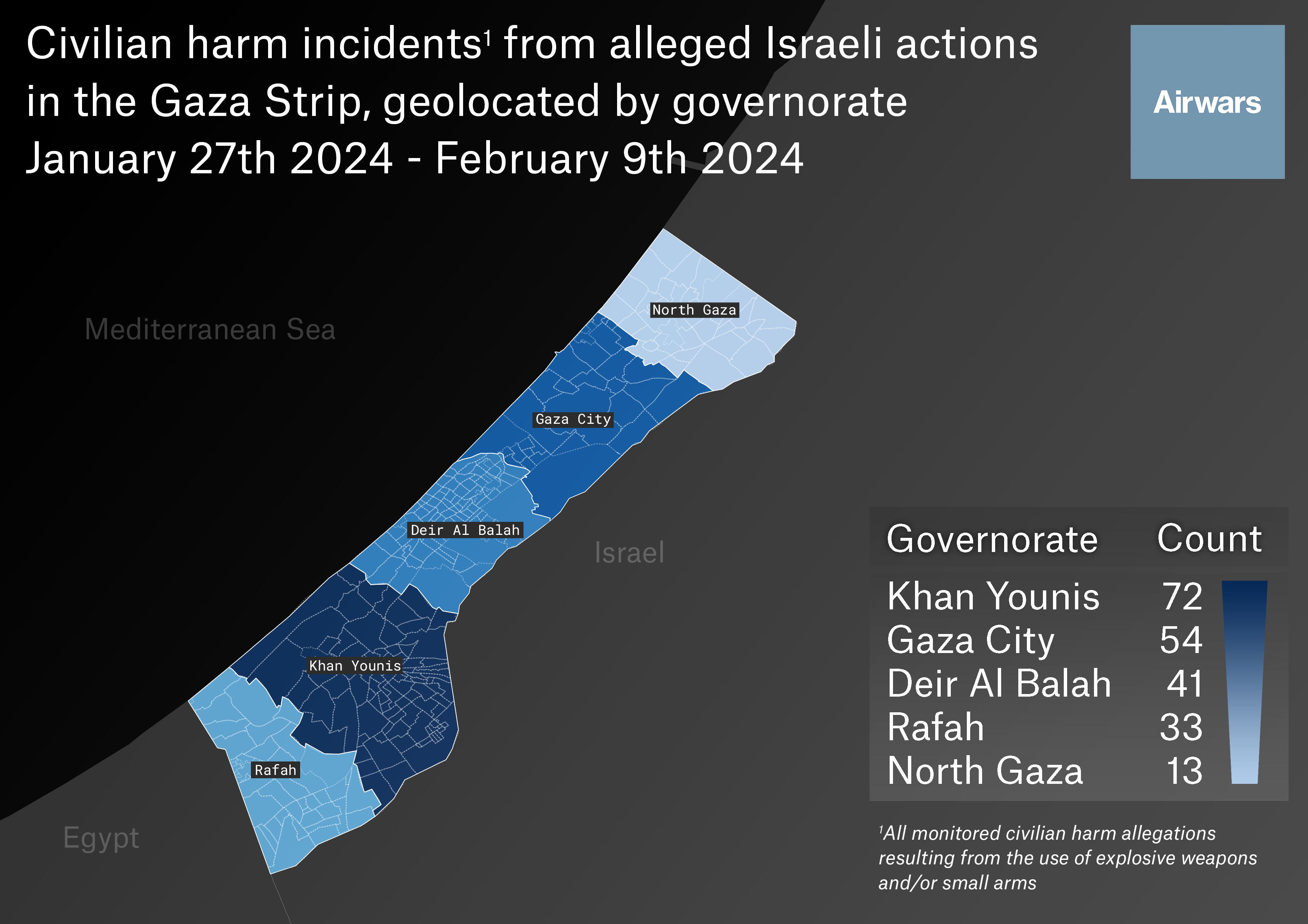Palestinian civilians allegedly killed every day in the two weeks following the International Court of Justice's ruling on Gaza, Airwars finds
On January 26th, the International Court of Justice ordered provisional measures in a case brought by South Africa alleging that Israel was violating its obligations under the 1948 Genocide Convention in Gaza. Israel refuted the claim, stating it was taking all possible measures to protect civilians during its attempts to destroy the Palestinian militant group Hamas.
The ICJ found that a plausible risk of genocide in the Gaza Strip exists and that Israel must take all measures within its power to prevent genocide, to prevent and punish incitement to genocide, make provision for access to humanitarian aid, ensure preservation of evidence related to South Africa’s allegations, and must report back to the Court within a month about how it was complying with this order.
However concerns have mounted over the destruction of evidence related to civilian harm claims given widespread attacks on healthcare facilities and the highly restrictive operating environment.
To provide independent incident-based research to support investigations into civilian harm claims, Airwars’ research team carried out an expedited assessment process gathering and reviewing all civilian harm allegations in the first two weeks of the month-long period.
Airwars research identified more than 200 alleged incidents of harm from January 27th 2024 to February 9th 2024, originating from more than 1,500 open source claims. These claims include local media outlets, testimonies from family members, and other witness testimonies posted online. Each incident was identified by corroborating at least five sources detailing the civilian harm event.
There are likely to be other incidents that were not publicly reported upon, however this research intends to provide a starting point for further investigation.
Among the claims, Airwars has identified attacks on journalists, on civilians while sheltering in displacement centres, on civilians waiting for humanitarian aid and on healthcare workers.
Airwars is still reviewing these cases through our rigorous casualty recording methodology, which means that no overall fatality estimates will be produced at this time. However these incidents still reveal some key patterns of harm.
Among the key trends were:
- Civilians were reported killed every day in incidents during the two-week period, with an average of 16 casualty incidents recorded per day.
- In 190 of the incidents, civilians were reported killed or injured following the alleged use of explosive weapons. In 36 incidents, civilians were allegedly shot and killed or injured by live fire.
- Healthcare workers and first responders were reported killed in six incidents.
- Civilians waiting for humanitarian aid were reported killed or injured in five separate incidents.
- Civilians in education centres were reported killed or injured in eight separate incidents, often while taking shelter.
- Journalists were reported killed in at least five of these incidents, often alongside members of their family.
- In 13 separate incidents, at least ten civilians were alleged to have been killed.
- Geographically the largest number of incidents occurred in the governorate of Khan Yunis, which Israeli forces were seeking to take control of during the time period.
Out of the 233 incidents identified by Airwars, our geolocation teams were able to locate 213 to governorate level – key administrative units in Gaza. These incidents are reflected on the map. Further precision on geolocations will be part of Airwars’ forthcoming and comprehensive assessment of each incident.
Incidents include harm from explosive weapon use and to the extent possible from the use of small arms or light weapons. Each incident has not yet been through Airwars’ rigorous assessment process, and therefore data points should be treated as provisional only, including on civilian status and casualty ranges.
Chronology of harm
Key incidents are described chronologically below, and full datasets can be provided on request including with digitally archived links. The following should not be understood as an exhaustive list, but rather a brief summary of each day’s events – as reported by local sources.
More comprehensive analysis will be released once we have completed our full documentation efforts, including the more than 2,000 incidents yet to go through our review process.
January 27th 2024
Civilians alleged to have been killed while waiting for humanitarian aid, as well as in shootings in a hospital courtyard.
January 28th 2024
More than ten civilians reported killed in a single incident in a refugee camp, dozens reported injured while waiting for humanitarian aid, and at least one civilian killed in a school. A journalist was also reported killed.
January 29th 2024
More than ten civilians reported killed in at least three separate incidents, including while sheltering in a school. At least two incidents of identified civilian casualties in a hospital due to shootings. One journalist also reported killed.
January 30th 2024
More than ten civilians reported killed during one incident, as well as other incidents recorded of casualties during aid distributions.
January 31st 2024
Civilians reported killed while sheltering in a collective displacement centre, as well as harm reported on ambulance and first responder crews.
February 1st 2024
Healthworkers reported killed near a hospital entrance, as well as widespread reporting of 22 bodies recovered in Khan Younis.
February 2nd 2024
At least two incidents identified where health workers were reported killed.
February 3rd 2024
More than ten civilians reported killed during an alleged Israeli bombing on a family home.
February 4th 2024
Multiple reports of civilians killed and injured while waiting to receive humanitarian aid. Additional casualties reported in a kindergarten.
February 5th 2024
Civilian casualties reported in education facilities in Khan Younis.
February 6th 2024
At least two incidents where more than ten civilians were reported killed, including in an alleged strike on a family home. Two journalists also reported killed.
February 7th 2024
More than ten civilians killed in a single incident, and additional casualties reported in medical facilities. Several civilians also reported killed while waiting for humanitarian aid.
February 8th 2024
More than ten civilians killed in a single incident, and at least two incidents recorded where healthcare workers were killed, and one incident where civilians were killed in a health centre. One journalist also reported killed.
February 9th 2024
One incident where more than ten civilians were reported killed, another incident where casualties were recorded in medical centres, at aid distributions and also, separately, in an education facility.
Airwars’ ongoing casualty recording efforts
Following the brutal October 7th Hamas attack, Israel launched one of the most intense military campaigns in modern history in Gaza. In the months since, almost every fact emerging has been in dispute.
In an attempt to combat mis- and disinformation and build a permanent public record of civilian harm, Airwars has been recording incident-by-incident civilian harm allegations since October 7th. By utilising Airwars’ open source-led primary language methodology – used to document civilian harm caused by different belligerents in multiple conflict zones including Iraq, Syria and Ukraine – researchers have so far identified more than 2,500 separate allegations of civilian harm in Gaza. These range from incidents in which one or two civilians were reported injured to those in which more than 100 Palestinians have been reported killed.
To date more than 280 incidents have been through a rigorous six-stage verification process and are available on our website in a new archive. Due to the scale of the task and the rigour of the process, most of these relate to the first month of the war. Dozens more are published each week once they have completed the full review process. A forthcoming report will highlight key trends from those published incidents.


